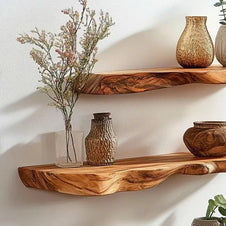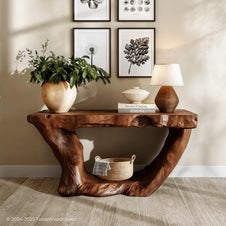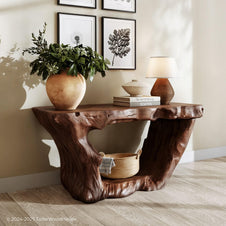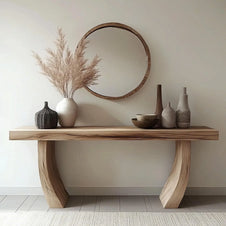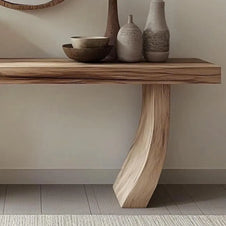Looking to save space without sacrificing style? A DIY floating side table is the perfect solution. With the right tools and a clear guide, you can create a modern, compact piece that functions as a bedside shelf or wall-mounted nightstand. This article will walk you through the entire process, from materials to styling, so you can enjoy a customized design for your room.
Why a Floating Side Table is the Perfect Bedroom Upgrade
Choosing a DIY floating side table is not just about saving space; it’s about transforming how your bedroom feels and functions. Let’s break down the key reasons this small project makes such a big difference:
-
Maximizes limited space
A traditional nightstand often takes up valuable floor area. In contrast, a DIY floating side table attaches directly to the wall, leaving the floor clear for easier cleaning and better movement in compact rooms.
-
Creates a modern, minimalist aesthetic
Floating designs remove visual clutter and give your room an open, airy feel. The sleek appearance of a wall-mounted side table instantly updates your bedroom style, whether you prefer rustic wood or a painted modern finish.
-
Customizable to your needs
One of the biggest advantages of a DIY floating side table is flexibility. You decide the size, height, finish, and even whether to add storage features like small drawers or hidden shelves.
-
Adds functionality without heaviness
By combining storage with simplicity, floating side tables provide a surface for essentials - like a lamp, phone, or book - without overwhelming the room.
-
Affordable upgrade with personal value
Instead of spending on expensive furniture, you can build one with basic tools and affordable materials. The sense of accomplishment from completing a project yourself is priceless.
In short, a floating side table is more than just furniture - it’s a smart solution for comfort, style, and practicality.
Gathering the Right Tools and Supplies
Before jumping into the fun part, you’ll need to prepare the right tools. Many people underestimate this step, but having the right setup saves time and prevents frustration. For a DIY floating side table, the basics are simple:
-
Measuring tape and pencil – to get precise dimensions.
-
Drill and wall anchors – for safe, stable installation.
-
Wood boards – hardwood works best for durability.
-
Sandpaper and finish – to smooth edges and protect the wood.
-
Brackets or hidden supports – depending on the style you choose.
When choosing wood, think about durability and aesthetics. Solid hardwood will last for years and give your room a natural warmth, while lighter options like pine are easier to cut and budget-friendly. If this is your first DIY floating side table, start simple with sturdy materials that are easy to handle.
You can also skip the cutting and drilling stage by choosing a ready-made option. A great choice is this slim profile bedside table, which offers floating brackets and compact storage. This is especially useful for beginners who want the benefits of a DIY floating side table without worrying about advanced carpentry skills.
With tools and materials ready, you’re set to move on to the next stage: building your own DIY floating side table that matches your space perfectly.

Step-by-Step Guide to Building Your Floating Side Table
Building a DIY floating side table may seem intimidating at first, but breaking it down into clear steps makes the process simple and enjoyable. Whether you’re new to woodworking or just looking for a weekend project, this guide will walk you through every detail. By the end, you’ll have a personalized table that fits your style and space.
Planning and Measuring for Precision
Every successful DIY floating side table starts with accurate planning. Decide how high you want the table to sit - ideally level with your mattress for convenience. Use a measuring tape to mark the wall and double-check all dimensions before drilling. Careful planning ensures your table is practical and visually balanced.
Cutting and Preparing the Wood
Once your measurements are set, cut your wood boards to the chosen size. Sand the edges thoroughly to avoid splinters and create a polished finish. Proper preparation is key because rough, uneven wood will affect the final look of your DIY floating side table.
Assembling the Structure
Now it’s time to bring the pieces together. Attach brackets or hidden supports to the underside of the board, making sure everything is level and stable. Choosing hidden brackets will give your DIY floating side table that sleek “floating” effect, while visible brackets can add character depending on your design style.
Mounting on the Wall
The final step is securing your table to the wall. Drill holes at the marked points, insert wall anchors, and then mount the table securely. Test its strength by gently pressing down on the surface. If you want a clear visual walkthrough, this video tutorial demonstrates the mounting process in detail and can help you avoid common mistakes. Once your DIY floating side table is safely installed, decorate it with essentials like a lamp, books, or a small plant for a cozy finish.
Creative Styling Ideas for Your DIY Floating Side Table
Designing your DIY floating side table doesn’t stop once it’s mounted - the real fun comes from styling it to fit your personal taste. The right finish, accessories, and placement can transform a simple wall-mounted surface into a statement piece in your bedroom. Here are a few inspiring approaches:

-
Modern minimalism: Keep the top clean and uncluttered, limiting accessories to just a book or a slim lamp. Painting your DIY floating side table in matte black or crisp white enhances the sleek, contemporary effect.
-
Compact elegance: Small bedrooms benefit from narrow, space-saving designs. The solid timber floating nightstand is ideal for those who want warmth and simplicity in a small footprint.

Ultimately, the way you style your DIY floating side table depends on your lifestyle. Minimalists can enjoy the clean look of hidden brackets, while cozy decorators may prefer layering plants, candles, and framed photos.
Caring for Your Floating Table Over Time
Taking care of your DIY floating side table is essential if you want it to remain strong, stylish, and practical for years. Unlike bulky furniture, a floating table is lightweight but still needs regular attention to maintain its durability and appearance.
-
Dust regularly to prevent buildup that dulls the surface.
-
Polish or re-oil the wood every few months to keep it looking fresh.
-
Inspect brackets and anchors twice a year to ensure your DIY floating side table stays securely attached to the wall.
If you prefer a low-maintenance option, consider designs built for long-term stability. A great example is the compact floating bed table, which features strong mounting hardware that makes upkeep almost effortless. Choosing durable materials and checking stability regularly will help your DIY floating side table stay safe and functional for everyday use.

Mistakes That DIYers Often Make
Even the most careful DIYers can run into challenges when building a DIY floating side table. Knowing the common mistakes in advance will help you avoid frustration and keep your project safe and stylish.
-
Skipping wall anchors: Many beginners underestimate the weight a floating table can hold. Without proper wall anchors, the shelf can sag or pull out over time. You can learn proper installation methods from this step-by-step floating nightstand guide.
-
Wrong measurements: Not measuring your wall space or the table’s height carefully often results in a surface that’s too high, too low, or awkwardly placed beside the bed.
-
Overloading the table: A DIY floating side table is meant for essentials - like a lamp, book, or phone - not for stacking heavy objects. Too much weight can damage both the table and the wall.
By keeping these mistakes in mind, you’ll not only protect your work but also extend the life of your new floating table.
FAQs
How much weight can my floating table hold?
Most floating tables can hold between 15 and 40 pounds, depending on wall anchors and wood thickness.
Can I build one without drilling?
Yes, but adhesive or no-drill solutions only work for very lightweight setups. For safety, drilling is best.
Which wood is best for a side table?
Hardwoods like oak, walnut, or maple are the most durable. Pine works for budget builds but won’t last as long.
How do I make my floating table look stylish?
Keep clutter minimal, add a small lamp, and coordinate with your bedroom’s overall style for balance.
Final Thoughts
A DIY floating side table is more than just a furniture project - it’s a way to take control of your space and style. Whether you live in a studio apartment or a large home, this compact design brings elegance and function without crowding your floor. With the right tools, careful planning, and a touch of creativity, you can build a piece that feels tailor-made for your bedroom.
Instead of settling for bulky furniture, try building one yourself. The sense of satisfaction is priceless, and you’ll end up with a table that not only fits your needs but also tells your personal story. Start simple, take your time, and enjoy the process - you’ll be surprised at how much joy a small project can bring to your space.


